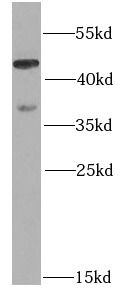Products
PSMC3 antibody
Category:
Research Area:
- SPECIFICATIONS
- Product Name
- PSMC3 antibody
- Catalogue No.
- FNab06879
- Size
- 100μg
- Form
- liquid
- Purification
- Immunogen affinity purified
- Purity
- ≥95% as determined by SDS-PAGE
- Clonality
- polyclonal
- Isotype
- IgG
- Storage
- PBS with 0.02% sodium azide and 50% glycerol pH 7.3, -20℃ for 12 months (Avoid repeated freeze / thaw cycles.)
Immunogen
- Immunogen
- proteasome (prosome, macropain) 26S subunit, ATPase, 3
- Alternative Names
- TBP1 antibody
- UniProt ID
- P17980
- Observed MW
- 49 kDa
Application
- Tested Applications
- ELISA, WB, IHC, IF
- Recommended dilution
- WB: 1:500 - 1:2000; IHC: 1:50 - 1:200; IF: 1:50 - 1:200
Validated Images
 HeLa cells were subjected to SDS PAGE followed by western blot with FNab06879(PSMC3 antibody) at dilution of 1:1000
HeLa cells were subjected to SDS PAGE followed by western blot with FNab06879(PSMC3 antibody) at dilution of 1:1000
 Immunohistochemistry of paraffin-embedded rat liver using FNab06879( PSMC3 Antibody) at dilution of 1:50
Immunohistochemistry of paraffin-embedded rat liver using FNab06879( PSMC3 Antibody) at dilution of 1:50
- Background
- The 26S proteasome is a multicatalytic proteinase complex with a highly ordered structure composed of 2 complexes, a 20S core and a 19S regulator. The 20S core is composed of 4 rings of 28 non-identical subunits; 2 rings are composed of 7 alpha subunits and 2 rings are composed of 7 beta subunits. The 19S regulator is composed of a base, which contains 6 ATPase subunits and 2 non-ATPase subunits, and a lid, which contains up to 10 non-ATPase subunits. Proteasomes are distributed throughout eukaryotic cells at a high concentration and cleave peptides in an ATP/ubiquitin-dependent process in a non-lysosomal pathway. An essential function of a modified proteasome, the immunoproteasome, is the processing of class I MHC peptides. This gene encodes one of the ATPase subunits, a member of the triple-A family of ATPases that have chaperone-like activity. This subunit may compete with PSMC2 for binding to the HIV tat protein to regulate the interaction between the viral protein and the transcription complex. A pseudogene has been identified on chromosome 9.



